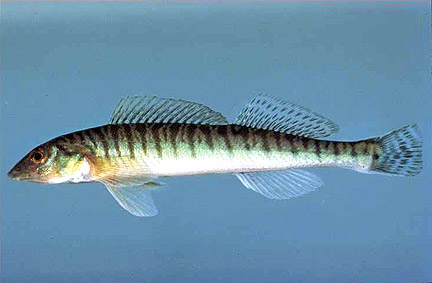
Percina caprodes
FAMILY
Percidae
TAXONOMY
Percina caprodes Rafinesque, 1818, Ohio River, United States.
Three subspecies are recognized.
OTHER COMMON NAMES
English: Manitou darter, zebrafish; French: Dard-perche,
fouille-roche.
PHYSICAL CHARACTERISTICS
Maximum total length 7 in (18 cm). Long, fusiform fishes with
conical nose and banding on the sides of the body that becomes
more irregular posteriorly. Body color is greenish
brown.
DISTRIBUTION
North America from Hudson Bay east to the Atlantic coast,
west to Saskatchewan, and south through the Great Lakes region
to the Gulf of Mexico.
HABITAT
Spread through many habitats, but primarily gravel- or sandybottomed,
medium-sized rivers. Also bottom dweller in weedy
lakes, usually some distance from the shoreline.
BEHAVIOR
Perhaps their most notable
BEHAVIOR
occurs during feeding,
when they frequently use their noses to root prey out of the
substrate and from beneath stones.
FEEDING ECOLOGY AND DIET
Feeds on zooplankton, particularly copepods.
REPRODUCTIVE BIOLOGY
Moves into shallow waters or rivers to spawn in the spring.
The male becomes more vividly colored and develops tubercles
on its ventral side. A gravid female approaches a school of
males, which follows her to the substrate. Following the release
of eggs and milt, the female and often the males engage in
rapid wriggling, which serves to churn up the bottom and bury
the eggs. No parental care for eggs or young.
CONSERVATION STATUS
Not listed by the IUCN.
SIGNIFICANCE TO HUMANS
None known.
Other popular Animals
Photo Gallery of - Logperch





 Animalia Life
Animalia Life